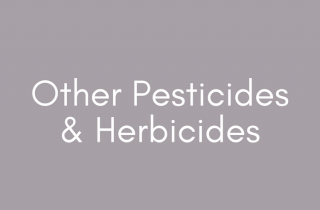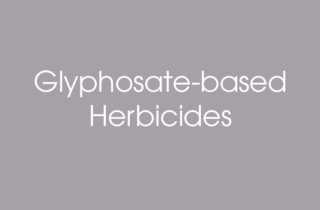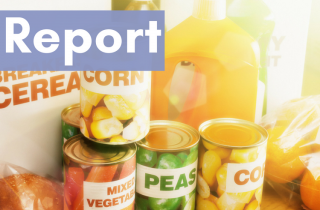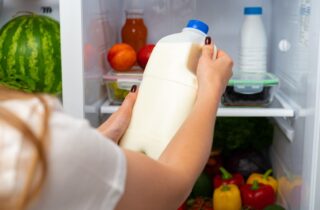Food Packaging Chemicals
At a Glance
Dangerous chemicals used in food production and packaging routinely migrate into food and beverage contents and, upon consumption, into our bodies. Over 180 chemicals linked with breast and other cancers are used in food production and packaging materials, with companies merely moving from one to the next.
Overview
Sources of Toxic Chemicals in our Food |
|
| Environmental contaminants | Plants, animals, and seafood absorb toxic pollutants from air, soil, and water. |
| Direct food additives | Chemicals intentionally added to food like flavors, colorants, or preservatives. |
| Indirect food additives (aka Food Contact Chemicals) | Chemicals from materials that contact food and beverage migrate into food/beverages. This includes chemicals in materials used in production like conveyor belts and tubes, in retail packaging, and in food cooking and service ware. |
Science summary
Food packaging is home to thousands of chemicals, and few of these, if any, are backed by publicly available scientific data affirming their safety. Minimal data displays the effect of chemical combinations or cumulative exposure to the multitude of chemicals residing in our food as a result of packaging and processing. In the U.S., it’s estimated that around 5,000 chemicals are used in processing and packaging materials, and around 5,000 are used as direct additives. Over 200 chemicals on the FDA-permitted list have already been identified as hazardous; beyond that figure, another 530 qualify for official hazard classification based on predictive hazard data.[1] A recent study examined a list of 921 chemicals linked to breast cancer and found that 189 chemicals were common in food contact materials.[2]
Chemicals linked to breast cancer used in food packaging and processing include BPA and other bisphenols, phthalates, PFAS ‘forever’ chemicals, vinyl chloride, and styrene. Some of these chemicals, like BPA, are rapidly cleared by the body (i.e., metabolized and excreted), meaning that when these are replaced with safer alternatives, bodily levels quickly decline. However, other chemicals linked to damage are more stubborn, like PFAS, meaning the body takes longer to clear them, or the chemical breaks down more slowly. The result: Those with prolonged or repeated exposure to these chemicals are at greater risk for adverse health effects, even if manufacturers replace them with a safer alternative.
Our Priority: Ban the worst chemicals in food packaging
BCPP prioritizes banning bisphenol A, six phthalates, and styrene—eight of the ten most frequently detected dangerous chemicals manufacturers use in food production and packaging from the list of 189 most common chemicals above.
BPA (Bisphenol-A)
Bisphenol-A or BPA is a hormone-disrupting compound toxic to human reproduction. BPA exposure is linked to precocious puberty (early-onset puberty), PCOS, and infertility, with early prenatal and infant exposure posing an even higher risk. In the past, BPA was widely used in baby bottles, sippy cups, infant formula packaging, steel food, and aluminum beverage can lining, and, recently, nonstick pans. Data from the U.S. Centers for Disease Control and Prevention (CDC) indicate that 93% of Americans have detectable levels of BPA in their urine. Unfortunately, recent tests of food products show that Bisphenols remain widespread in foods.
Thanks to the work of BCPP and our partners, the FDA banned BPA in baby bottles and sippy cups in 2012. Manufacturers have largely moved away from lining cans with BPA within the last five to ten years, although many keep their replacement chemicals a secret. This means that no one—not the U.S. Food and Drug Administration (FDA), academic scientists, or watchdog NGOs—can examine the science of these substitutes or assess their safety.
Phthalates
Exposure to phthalates is linked to breast cancer, developmental issues, decreased fertility, obesity, and asthma. Companies use hormone-disrupting phthalates in various materials that contact food, both upstream (in food production/processing) and downstream (in food packaging and serving). For example:
- Conveyor belts, milking equipment, and retail food service gloves often contain phthalates.
- Plastic food containers, jar lids, and bottle caps (gaskets) have phthalates.
- Some paper and paperboard packaging ink, lacquers, and adhesives (of the recycled pulp used to make these packaging articles) can also contain phthalates.
The good news is that multiple studies show that removing BPA and phthalates from food packaging can rapidly decrease the levels of these chemicals in people. One of these, conducted by BCPP and the Silent Spring Institute, found that three days of a fresh food diet resulted in an average decrease of 66% in BPA levels and 50% in phthalate levels.[3]
PFAS ‘forever’ chemicals
PFAS “forever” chemicals (i.e., per- and polyfluorinated chemicals) are a large group of dangerous chemicals linked to breast and other cancers, hormone disruption, kidney and liver damage, thyroid disease, developmental harm, infertility, immune system impairment, and most notably, a reduction in vaccine efficacy. PFAS chemicals are persistent: Found throughout the world in humans, animals, and our food supply, these break down very slowly in the environment. PFAS chemicals provide oil and water resistance and are used in or on paper, paperboard, and molded fiber packaging. For example, the PFAS lining of microwave popcorn bags and fast food containers keeps the oil and grease on the inside. PFAS are also used as lubricants or mold release agents during food container production. Furthermore, specific plastic manufacturing processes create PFAS that migrate from the plastic container to food and beverage. Currently, the FDA allows a certain number of PFAS in food packaging, but packaging may have additional PFAS chemicals because those permitted can break down into other PFAS chemicals.
Other toxic chemicals
Styrene and antimony trioxide are two other chemicals of concern commonly in food and beverage packaging materials. Styrene, widely found in Styrofoam and polystyrene (plastic No. 6), has been recognized as a “reasonably anticipated cancer-causing chemical” by the U.S. National Toxicology Program since 2011 based on the risk it poses in the development of occupational cancers (e.g., leukemia, lymphoma) and rodent cancers (lung). Despite this, studies show that styrene leaches from polystyrene bottles and Styrofoam cups. Our 2016 testing also found styrene in tin can linings.
Antimony Trioxide is used in PET plastic manufacturing. Though the U.S. National Toxicology Program recognized it as a reasonably anticipated carcinogen in 2018, and the State of California began recognizing it as a carcinogen in 1990 (added to Proposition 65 list of carcinogens and reproductive toxicants), studies still illustrate Antimony Trioxide’s presence in beverages contained in PET plastic.[4]
Harmful food chemicals replaced with mystery chemicals
Unfortunately, companies replacing known chemicals of concern don’t typically reveal the new alternative’s identity nor its accompanying health and safety data. BPA replacement is an example of this substitution pattern, but the same applies to replacing many different toxic chemicals in food packaging and production.
The BPA switch-out
We’ve been working diligently to educate and lobby policymakers about the dangers of toxic chemicals in food processing and packaging since 2006. Our Cans Not Cancer Campaign and emerging scientific research brought BPA to the forefront of the federal debate on toxic chemicals. As a result of this pressure, many manufacturers and retailers have moved away from BPA in can linings. Learn more about what the Cans Not Cancer Campaign is doing to eliminate BPA from food cans and for inspiration about what it takes to change a sector’s go-to toxic chemical.
Ongoing consumer demand for BPA-free and PFAS-free food packaging has driven manufacturers to use replacement chemicals. However, often, companies don’t reveal the identity of replacement chemicals, meaning the replacement might be just as dangerous. Typically, information about these replacements’ safety and potential toxicity isn’t available within the public sphere and may be unknown even to the companies using them. Research suggests that some of the chemicals replacing BPA are also endocrine disruptors.
Regrettably, substituting a dangerous chemical for another also applies to per- and polyfluorinated chemicals (PFAS) in paper-based food packaging. Some emerging data indicates that many shorter-chain PFAS chemicals replacing longer-chained ones may also yield adverse health effects.
Our 2016 report, “Buyer Beware: Toxic BPA and regrettable substitutes found in the linings of canned food,” written by BCPP in collaboration with leading experts, revealed the use of several troubling BPA alternatives, including PVC, which may contain residual levels of carcinogen vinyl chloride, and styrene acrylates, which can be contaminated with styrene, a mammary carcinogen.
[1] https://www.foodpackagingforum.org/news/fpf-publishes-food-contact-chemicals-database
[2] https://www.foodpackagingforum.org/news/food-contact-chemicals-among-921-substances-tied-to-breast-cancer-risk
[3] Rudell, R.A. et al., 2011. Food Packaging and Bisphenol A and Bis(2-Ethyhexyl) Phthalate Exposure: Findings from a Dietary Intervention, Environmental Health Perspectives Vol 119(7): 914-920 https://doi.org/10.1289/ehp.1003170
[4] Antimony in food packaging | Food Packaging Forum; Testing finds antimony in common beverages bottled in PET | Food Packaging Forum; https://www.foodpackagingforum.org/news/scientific-review-reveals-the-chemicals-migrating-from-pet-drink-bottles
Types: Article




